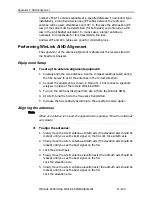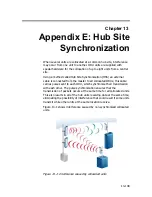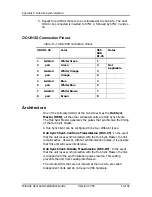
Appendix E: Hub Site Synchronization
WinLink User and Installation Guide
Version 1.750
13-151
5.
Repeat for all ODUs that are to be collocated at the hub site. The next
ODU to be connected is inserted to SYNC 2, followed by SYNC 3 and so
on.
ODU/HSS Connection Pinout
Table
13-1: ODU/HSS Connection Pinout
ODU RJ-45
Color
HSS
HUB
RJ-45
Notes
1 twisted
White/Green
1
2 pair
Green
2
3 twisted
White/Orange
3
Not
Applicable
6 pair
Orange
6
4 twisted
Blue
4
5 pair
White/Blue
5
7 twisted
White/Brown
7
8 pair
Brown
8
Architecture
One of the collocated ODUs at the hub site acts as the
Hub Sync
Master (HSM)
; all the other collocated units are Hub Sync Clients.
The Hub Sync Master generates the pulses that synchronize the timing
of the Hub Sync Clients.
A Hub Sync Client can be configured to be two different types:
Hub Sync Client–Continue Transmission (HSC-CT)
: In the event
that the unit loses synchronization with the Hub Sync Master, the link
remains active. However, without synchronization pulses, it is possible
that this unit will cause interference.
Hub Sync Client–Disable Transmission
(HSC-DT)
: In the event
that the unit loses synchronization with the Hub Sync Master, the link
is dropped until the synchronization pulses resume. This setting
prevents the unit from causing interference.
The remote ODUs that are not located at the hub site, are called
Independent Units and do not require HSS hardware.
















































